Buede D.M. The Engineering Design of Systems Models and Methods
Подождите немного. Документ загружается.

PROBLEMS
11.1 Describe a process of establishing conceptual validity that identifies the
elements of conceptual validity and links between pairs of these
elements. This process should then establish characteristics such as
completeness, consistency, and correctness.
11.2 Describe a process that could be used to establish requirements
validity. This process should identify the elements of moving from
the operational concept to the stakeho lders’ requirements, as discussed
in Chapter 6. Additional products beyond those discussed in Chapter 6
should be identifi ed that would enable the validation of such char-
acteristics as completeness, consistency, and correctness when compar-
ing the operational concept to the stakeholders’ requirements.
Examples of comparisons that should be involved are:
Matching of operational concept elements to elements of the external
systems diagram
Matching of operational concept elements to input/output
requirements
Matching the objectives hierarchy to elements of the external systems
diagram
Matching the objectives hierarchy to input/output requirements
Matching elements of the external systems diagram to input/output
requirements
Tracing input/output requirements to external items
Matching the objectives hierarchy to system-wide requirements
11.3 Describe the types of activities (similar to those in Problem 11.2) that
could be used to establish design validity. Identify intermediate
products that could be used for establishing design validity. In
particular, focus on developing the best definition of completeness
for requirements that you can.
11.4 Develop an operational concept, external systems diagram, objectives
hierarchy, and requirements for the qualification system for a traffic
light system.
11.5 Develop an allocated architecture for the qualification system for a
traffic light system.
PROBLEMS 371

Part 3
Supplemental Topics

Chapter 12
Graphical Modeling Techniques
12.1 INTRODUCTION
There are three categories of qualitative modeling approaches used as part of
the development of functional and allocated architectures during the engineer-
ing of systems: data modeling, process modeling, and behavior modeling. A
data model addresses the relationships among the inputs and outputs of a
system. A process model defines the functional decomposition of the system
function and the flow of inputs and outputs for those functions. A behavior
model defines the control, activation, and termination of system functions
needed to meet the performance requirements of the system. In addition,
object-oriented engineering is becoming a major force in software engineering
and is beginning to be employed in systems engineering; object-oriented
engineering uses these three domains as well. Within each of these three
approaches, as well as object-oriented engineering, there are a number of
methods that are currently being used in systems and software engineering, as
shown in Table 12.1. This table provides a subset of the modeling approaches
currently in use. This chapter provides a description and sample model
applications of each of the modeling techniques that comprise data, process,
and behavior modeling. SysML and its modeling methods as well as IDEF0
(Integrated Definition for Function Modeling) were covered in detail in
Chapter 3. As discussed in Chapter 9, balancing or aligning the elements of
multiple modeling techniques is important in the development of the functional
and allocated architec tures.
The Engineering Design of Systems: Models and Methods, Second Edition. By Dennis M. Buede
Copyright
r 2009 John Wiley & Sons, Inc.
375

12.2 DATA MODELING
There are many approaches to data modeling. This section describes two
different modeling techniques. Entity–relationship (ER) diagrams are the
oldest form of data modeling. Higraphs are the most formally based approach
and offer the most power.
Two other approaches, IDEF 1 and IDEF1X, were developed within the
IDEF community but are not discus sed in detail here. IDEF1 models data
using entity classes and relations among entity classes. An entity class has
attributes that describe the entity. The relations that are possible between
classes come from entity–relationship diagrams and address mainly relation-
ships that are one-to-one, one-to-many, and so forth. IDEF1 is an approach for
modeling the structure of information as the information is maintained in an
organization, including the business rules [Griffith, 1994]. IDEF1X also models
data using entity classes and relations among the classes. IDEF1X allows for a
TABLE 12.1 Functions of the design process
Design Function Major Inputs Major Outputs
Define Problem To Be Solved Concerns and
Complaints by
Stakeholders
Definitions of Measures of
Effectiveness and Desired
Ranges
Available Data from
Stakeholders
Constraints
Develop and Evaluate
Alternate Concepts for
Solving Problem
Ideas for Concepts
from All Interested
Parties
Recommended Concept(s)
Objective Hierarchy & Value
Parameters for Meta-
System
Define System Level Design
Problem Being Solved
Stakeholders’ Inputs Stakeholders’ Requirements
Operational Concept
Develop System Functional
Architecture
Stakeholders’
Requirements
Functional Architecture
Operational Concept
Develop System Physical
Architecture
Stakeholders’
Requirements
Physical Architecture
Develop System Allocated
Architecture
Stakeholders’
Requirements
Allocated Architecture
Functional
Architecture
Physical Architecture
Interface Architecture
Develop Interface Architecture Draft Allocated
Architecture
Interface Architecture
Develop Qualification System
for the System
Stakeholders’
Requirements
Qualification System Design
Documentation
Systems Requirements
376
GRAPHICAL MODELING TECHNIQUES
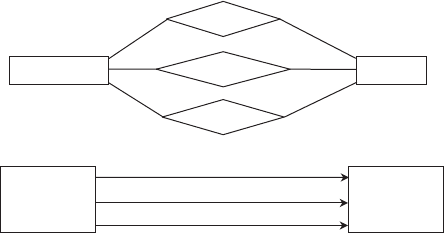
fuller definitio n of subtypes and attributes in term s of their aliases, data type,
length, definition, primary key, discriminator, alternate keys, an d inversion
entities than does IDEF1. Similarly, the relationships in IDEF1X may be
defined on the arcs and include one-to-one, one-to-many, and so forth.
IDEF1X is used for designing relational databases [Griffith, 1994]. The
interested reader shou ld see the FIPS PUB 184 [1993] on IDEF1X.
12.2.1 Entity–Relationship Diagrams
Entity–relationship diagrams model the data structure or relationships between
data entities. Art entity is a class of real, similar items (e.g., people, books,
computers). Entity types are shown in boxes; relationships are shown in
diamonds or as labels on the arcs. If diamonds are used, the graph has no
directed edges (with one exception). The relationship is usually read from left to
right or from top to bottom, but this is not universal [see Yourdon, Inc., 1993].
When the edges are directed, the relationship is read in the direction of the edge.
Figure 12.1 shows examples of both directed edges and diamonds.
The exception for directed edges when diamonds and undirected edges are
being used is called an associative entity. The associative entity is important
when there will be important data that is related to the relationship, as well as
the entities connected with the relationship. For example, a bank may wish to
keep data about each transaction (e.g., deposit, withdrawal). In this case, the
relationship is placed in a box, like an y entity would be, and the edge
connecting the box housing the relationship to the diamond in which the
relationship would have been placed becomes a directed edge, the direction of
which can be in either direction [see Yourdon, Inc., 1993; Yourdon, 1989].
Figure 12.2 shows an exampl e of an associative entity.
A unique relationship is that of supertype/subtype, which has become
known as a class/subclass relationship and is shown in Figure 12.3. A common
way to define a supertype/subtype relationship is by the relation ‘‘is-a.’’ An is-a
relationship can be based upon a partition of an entity or a subdivision that is
Customer Money
Deposits
Withdraws
Transfers
Deposits
Withdraws
Transfers
Customer Money
FIGURE 12.1 Simple entity–relationship diagram.
12.2 DATA MODELING 377

not a partition. For example, if there are only two types of accounts offer ed by
a bank, the relation shown in Figure 12.3 is based upon a partition; if there was
a third type of account, the relation is not based on a partition. Many of the
entities and relationships associated with systems engineering that we have
discussed so far are shown in Figure 12.4. Are the subtypes shown for
requirement a partition or not?
Another type of relationship is called a binary relationship; this is exactly the
same as the relations that we discussed in Chapter 4 and including both unary
and binary relations. Unary relations are relationships among instances of the
same object. These relationships can be reflexive. Figure 12.4 does not show any
of these relationships because there are no instances of any entities shown.
Binary relationships among instances to two different objects are binary relations
and must be irreflexive. The relationship ‘‘built-from’’ is an example of a binary
relationship. These binary relationships can be one-to-one, one-to-many,
many-to-one, or many-to-many. Some ER methods make the finer distinction
between one and zero-or-one, many, and zero-one-or-many.
12.2.2 Higraphs
Harel [1987] introduced higraphs as a generalization of Venn diagrams and ER
diagrams. Figure 12.5 shows a higraph for a subset of the ER diagram of
systems engineering shown in Figure 12.4. An entity is considered to be a set
with multiple elements, called a blob. A blob is represented as an enclosed area;
see system-wide requirement in Figure 12.5. Atomic sets are blobs with no other
blobs contained within them; the only nonatomic blobs in Figure 12.5 are
Customer
Money
Transaction
FIGURE 12.2 Associative entity.
Accounts
Savings Checking
FIGURE 12.3 Class/subclass relationship diagram.
378
GRAPHICAL MODELING TECHNIQUES
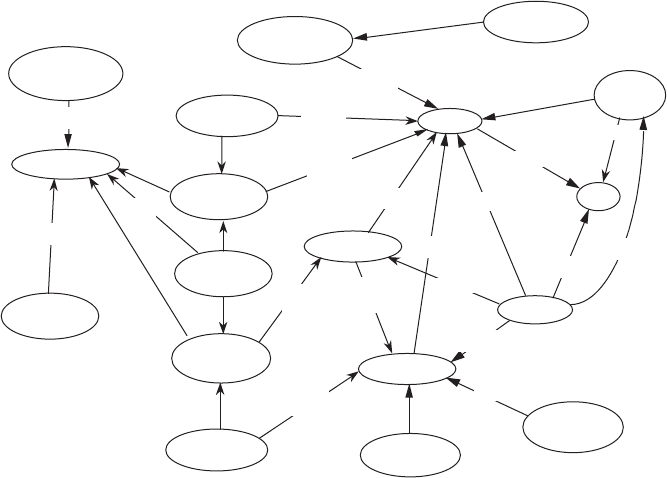
requirements, time, and compon ents. (To be correct we should have placed
blobs inside the eight intersections of stakeholders’ and derived requirements
with input/output, system-wide, trade-off, and test requirements. However, this
would have compromised the readability of the figure.) The is-a relationship
from ER diagrams is replaced by representing one entity as a subset of another.
Cartesian products (unordered n-tuples) are shown by placing a dashed line
between blobs inside a larger blob repres enting the n-tuple. See the time blob,
representing a four-tuple of year-month-day-hour in Figure 12.5. This concept
is not in Figure 12.4.
In higraphs the relation is shown in diamonds with an undirected line
entering the diamond and an arc leaving the diamond to indicate which way the
relation is read.
12.3 PROCESS MODELING
This section addresses data flow diagrams and N
2
charts.
12.3.1 Data Flow Diagrams
Data flow diagrams (DFDs) are one of the original diagramming techniques,
popular primarily with the software and information systems communities.
Originating
Requirements
Document
Requirement
Derived S-W
Requirement
documents
is-a
Input/Output
Requirement
System-wide
Requirement
Function
Functional
Architecture
Functional
Decomposition
Item
Physical
Architecture
Component
Configuration
Item
Interface
External
System
documents
contains
performs
performs
performs
contains
is-a
carries
connects
connects
System
performs
traced
to
traced
to
built
from
connects
Derived I/O
Requirement
traced
to
traced
to
traced
to
is-a
Test
Requirement
is-a
is-a
Trade-Off
Requirement
is-a
is-a
produces/transforms
produces/transforms
traced
to
FIGURE 12.4 Complex ER diagram of systems engineering.
12.3 PROCESS MODELING 379
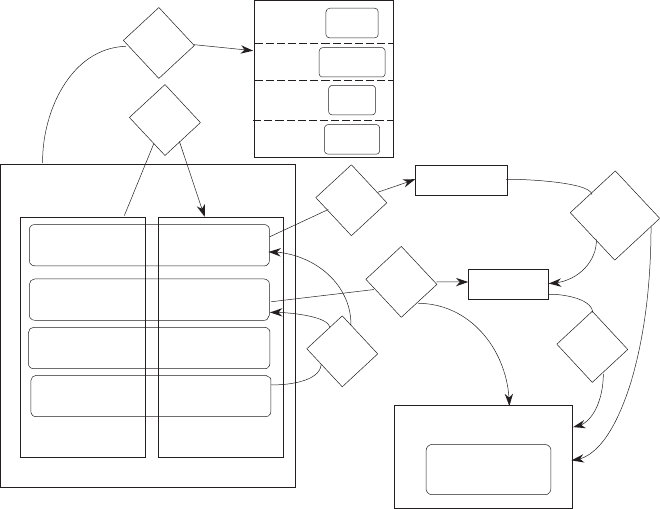
The basic constructs of data flow diagrams, shown in Figures 12.6–12.9, are the
(1) function or activity, (2) data flow, (3) store, and (4) terminator.
The circle is the most standard representation for a function. Arcs again
represent the flow of data or information between functions, or to and from
stores. Double-headed arcs are allowed; these represent dialog between two
functions, for example, a query and a response. The labels for an arc are placed
near each arrow. Branches are allowed and are depicted as forks. Branch
labeling conventions in data flow diagrams are the same as those for IDEF0;
see Figure 12.7. Joins are also permitted [Hatley and Pirbhai, 1988].
A new concept is introduced: the store or buffer, a set of data packets at rest.
Again there are several legal representations of a store, as shown in Figure 12.8.
In fact, a store is a physical solution based upon a number of problems; for
example, unreliable hardware, different programmers implementing software
that uses the same data, or growth potential for future enhancements. There is
no need for a store in a representation of ‘‘the essential requirements of the
system’’ [Yourdon, 1989, p. 151]. Stores are typically only shown on the level
one functional decomposition [Hatley and Pirbhai, 1988].
The final syntactical element of data flow diagrams is the terminator, or
external system in the language of Chapter 6. In fact, an ancestor diagram that
Requirement
Input/Output
Requirement
Originating
Requirement
Derived
Requirement
System-Wide
Requirement
Test
Requirement
Function
traced
to
traced
to
traced
to
System
performed
by
built
from
Component
Configuration
Item
traced
to
Time
Month
Year
Day
Hour
defined
on
Trade Off
Requirement
FIGURE 12.5 Partial higraph representation of the systems engineering ER diagram.
380
GRAPHICAL MODELING TECHNIQUES
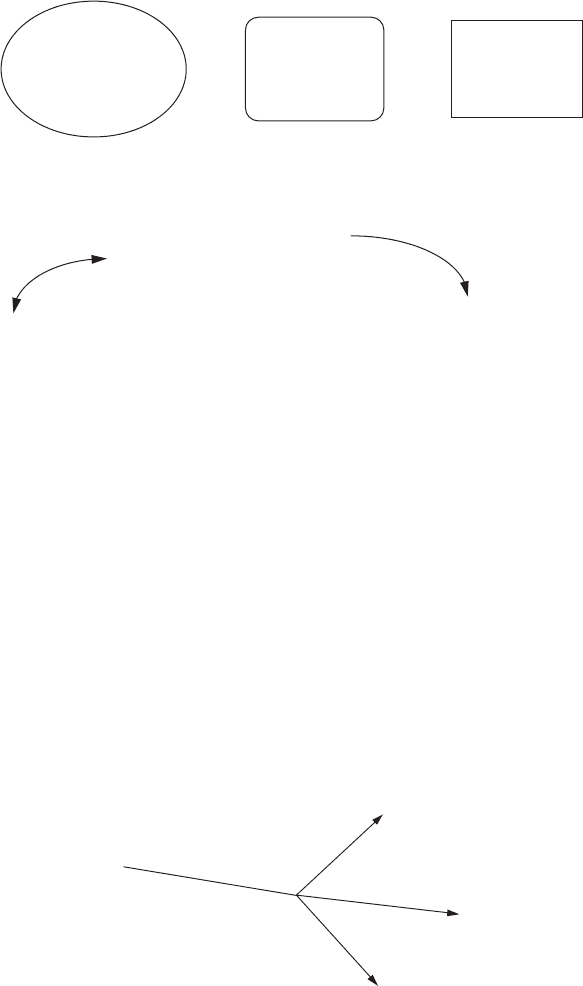
shows the interaction between the external systems, or terminators, and the
system being designed or analyzed, are standard in data flow diagrams (see Figure
12.9). Terminators are shown in boxes with the system being placed in an oval.
Yourdon’s guidelines for constructing DFDs are focused toward both
correctness and communicability:
1. Choose meaningful names for the processes, flows, stores, and
terminators.
2. Number the processes.
3. Redraw the DFD as many times as necessary for aesthetics.
4. Avoid overly complex DFDs.
5. Make sure the DFD is internally consistent and consistent with any
associated DFDs.
Process
Customer
Banking
Transactions
Process
Customer
Banking
Transactions
Process
Customer
Banking
Transactions
These are three equally valid representations of a process.
Note a process begins with a verb, just as functions or activities
do in IDEF0.
Customer Notice:
Main Menu
Selection
This is an example of a “data
flow”. Note it is a noun
phrase and attached to an arc.
Double-headed
arcs signify dialog
between functions
FIGURE 12.6 Semantics of data flow diagram.
x
1
⊆ x, x
2
⊆ x, x
3
⊆ x
x
1
x
2
x
3
x
FIGURE 12.7 Branches in data flow diagrams.
12.3 PROCESS MODELING 381
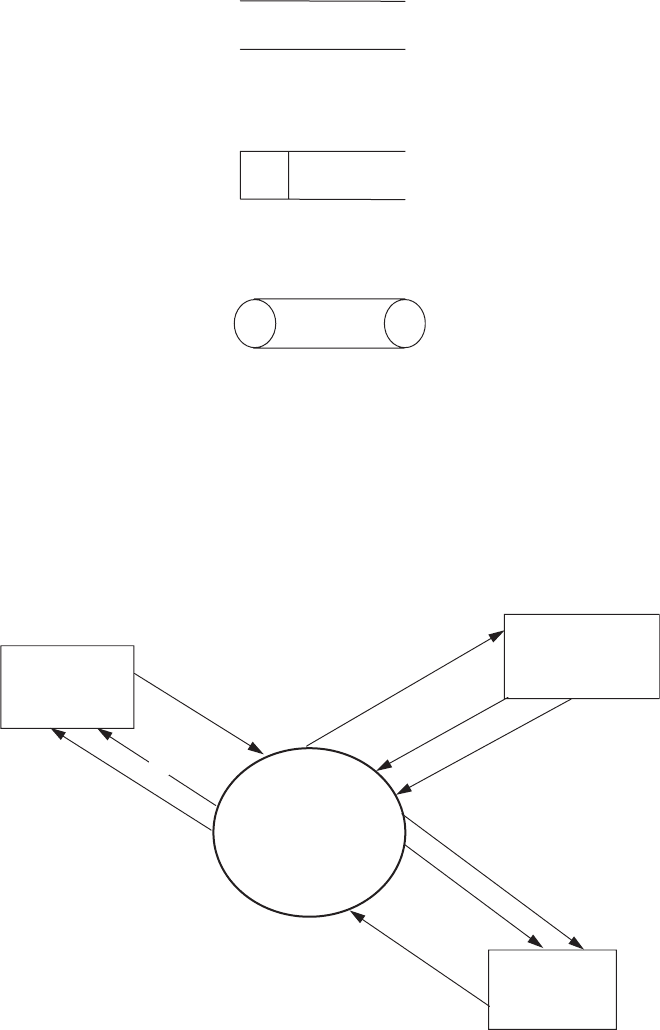
Note that process names are verb–object phrases and are usually capitalized.
Flows are noun phrases and are not capitalized. Hierarchical numbers are
recommended along with the use of leveled DFDs in order to avoid complex
DFDs. Leveled DFDs follow many of the guidelines of IDEF0 deco mposition.
ACCOUNT
NUMBERS
D1 ACCOUNT
NUMBERS
ACCOUNT
NUMBERS
FIGURE 12.8 Alternate representations of a store or buffer.
CUSTOMERS
BANK SERVICE
PERSONNEL
BANK
COMPUTER
Completed
Transaction
Prodcuts
Customer
Inputs
System
Status
Report
Account
Transaction
Data
Completed
Trans. Info.
Bank's
Acct. Info
Bank
Supplies
Employee
ID Info
PROVIDE
AUTOMATED
TELLER
MACHINE
SERVICES FOR
CUSTOMERS
Customer
Notices
(CN)
FIGURE 12.9 Context diagram using a data flow diagram.
382
GRAPHICAL MODELING TECHNIQUES
